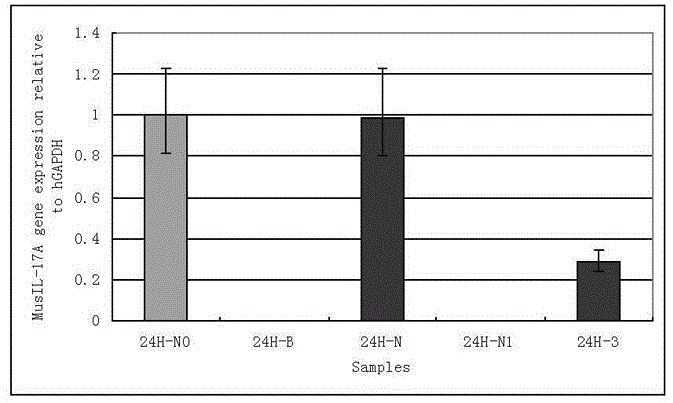Sequence siRNA-288 achieving targeted inhibition of mouse interleukin-17A gene
A technology of siRNA-288 and interleukin, applied in DNA/RNA fragments, gene therapy, recombinant DNA technology, etc., to achieve the effect of curing diseases
- Summary
- Abstract
- Description
- Claims
- Application Information
AI Technical Summary
Problems solved by technology
Method used
Image
Examples
Embodiment 1
[0022] The present invention is described below in conjunction with embodiment.
[0023] 1. Sequence design:
[0024] The siRNA interference sequence is designed for the mIL-17A gene for the synthesis of shRNA, and the siRNA-288 gene sequence is SEQ.No.1.
[0025] 2. Construction of mIL-17A interference vector:
[0026] 2.1 OligoDNA design and synthesis:
[0027] The loop structure in the shRNA template uses TTCAAGAGA to avoid the formation of a termination signal, and the shRNA transcription termination sequence adopts the T6 structure. CACC is added to the 5' end of the sense strand template, which is complementary to the sticky end formed after digestion with BbsI; GATCC is added to the 5' end of the antisense strand template, which is complementary to the sticky end formed after digestion with BamHI; if the shRNA first If a base is not G, add a G after CACC. The mouse IL-17A gene shRNA oligonucleotide sequence (shRNA-288oligoDNA) is shown in Table 1. The design and syn...
PUM
 Login to View More
Login to View More Abstract
Description
Claims
Application Information
 Login to View More
Login to View More - R&D
- Intellectual Property
- Life Sciences
- Materials
- Tech Scout
- Unparalleled Data Quality
- Higher Quality Content
- 60% Fewer Hallucinations
Browse by: Latest US Patents, China's latest patents, Technical Efficacy Thesaurus, Application Domain, Technology Topic, Popular Technical Reports.
© 2025 PatSnap. All rights reserved.Legal|Privacy policy|Modern Slavery Act Transparency Statement|Sitemap|About US| Contact US: help@patsnap.com



